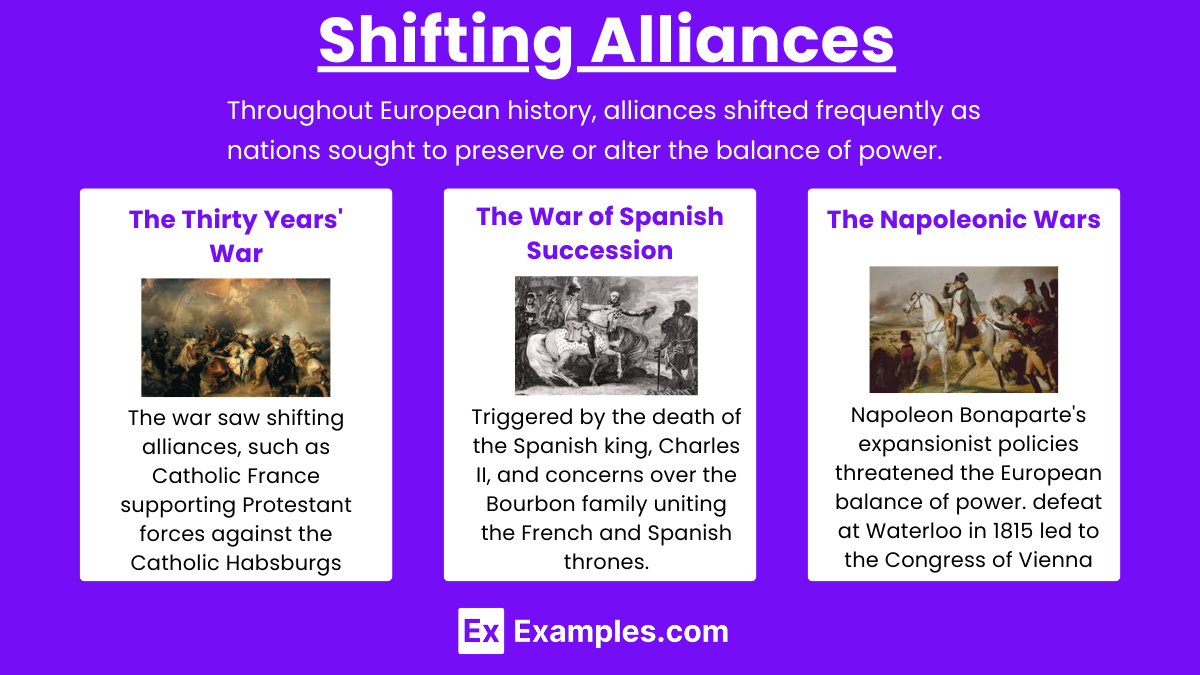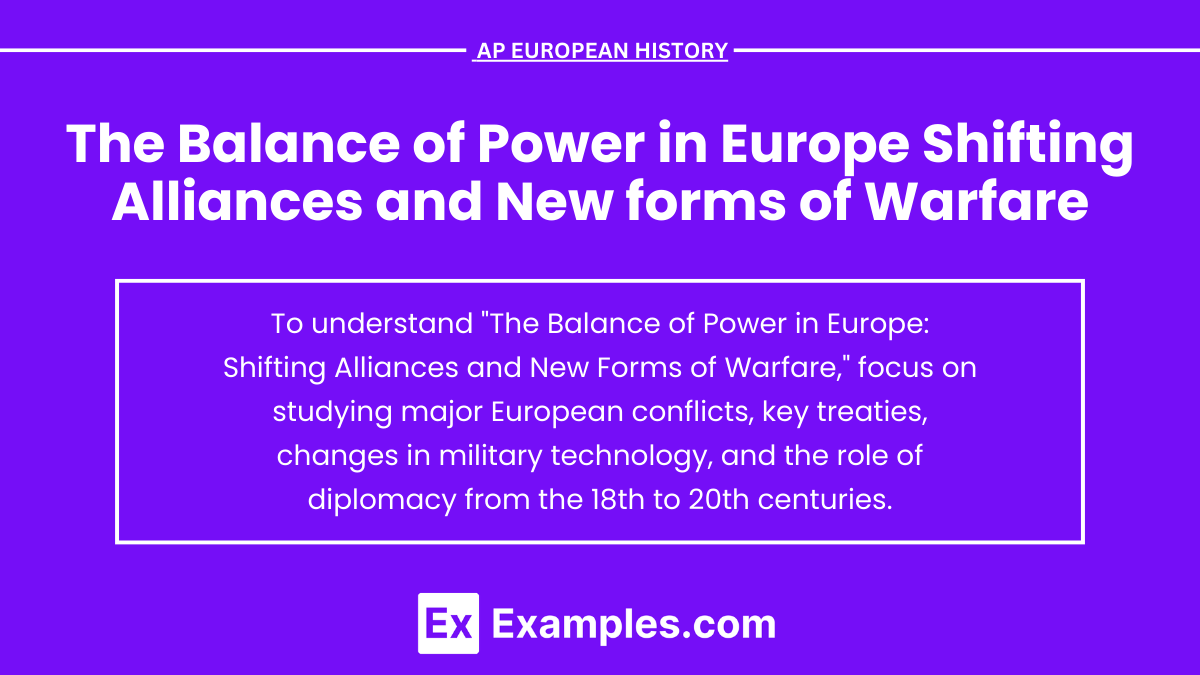The balance of power in Europe refers to a diplomatic strategy aimed at preventing any one nation from dominating the continent. This concept led to shifting alliances among European states, as countries sought to counterbalance the power of rivals. The period saw significant changes in warfare, including the rise of professional armies, advanced military technologies, and new tactical approaches. These dynamics played a crucial role in shaping Europe's political landscape, influencing major events like the Thirty Years' War, the War of Spanish Succession, and the Napoleonic Wars.
Learning Objectives
The Balance of Power in Europe: Shifting Alliances and New Forms of Warfare in AP European History, you should understand the intricate dynamics of political and military power among European states. Focus on how alliances shifted to maintain equilibrium and how military innovations changed warfare. Key conflicts to study include the Thirty Years' War, the War of Spanish Succession, and the Napoleonic Wars. Additionally, analyze the outcomes and significance of the Congress of Vienna and the Concert of Europe in shaping European diplomacy and statecraft.
The Concept of Balance of Power

The balance of power aims to ensure that no single nation can dominate others. This principle was fundamental in European diplomacy, particularly from the 17th century onwards. It encouraged states to form alliances to counteract any nation that appeared to be gaining too much power. The balance of power was not static; it required constant adjustments through wars, treaties, and diplomatic negotiations.
Key Elements:
Preventing Dominance: The primary goal was to prevent any single state from becoming too powerful.
Alliances: States formed alliances to balance against stronger powers.
Diplomacy and Warfare: Both diplomatic efforts and military engagements were used to maintain balance.
Shifting Alliances

Throughout European history, alliances shifted frequently as nations sought to preserve or alter the balance of power. These alliances were often temporary and based on mutual interests rather than ideological similarities.
The Thirty Years' War (1618-1648)
Background: A religious and political conflict that involved most of the major European powers.
Alliances: The war saw shifting alliances, such as Catholic France supporting Protestant forces against the Catholic Habsburgs, highlighting the complex and often pragmatic nature of alliances.
Outcome: The Treaty of Westphalia ended the war, establishing a new political order in Europe based on state sovereignty and non-interference in domestic affairs.
The War of Spanish Succession (1701-1714)
Background: Triggered by the death of the Spanish king, Charles II, and concerns over the Bourbon family uniting the French and Spanish thrones.
Alliances: The Grand Alliance, including Britain, the Dutch Republic, and the Holy Roman Empire, opposed the Bourbon claimants to maintain the balance of power.
Outcome: The Treaty of Utrecht (1713) curtailed French expansion and ensured that the French and Spanish crowns remained separate.
The Napoleonic Wars (1803-1815)
Background: Napoleon Bonaparte's expansionist policies threatened the European balance of power.
Alliances: The Coalition Wars saw various European powers, including Britain, Russia, Austria, and Prussia, form shifting coalitions against Napoleon.
Outcome: Napoleon's defeat at Waterloo in 1815 led to the Congress of Vienna, which aimed to restore the balance of power through the redrawing of Europe's political map and the establishment of a new diplomatic order.
New Forms of Warfare

Warfare evolved significantly from the early modern period to the 20th century. These changes had profound impacts on the balance of power and the nature of international relations.
Military Innovations
Gunpowder and Artillery: The widespread use of gunpowder revolutionized warfare, making traditional medieval fortifications obsolete and leading to new forms of military architecture.
Standing Armies: The 17th and 18th centuries saw the rise of professional standing armies, replacing feudal levies and mercenary forces. This change allowed states to maintain more permanent and disciplined military forces.
Naval Warfare: Naval power became increasingly important, particularly for colonial powers like Britain and the Netherlands. The development of larger, more powerful warships transformed naval battles and enabled the projection of power across the globe.
Tactics and Strategies
Linear Tactics: In the 17th and 18th centuries, linear tactics dominated European battlefields. Armies were arranged in long lines to maximize firepower and control.
Mass Conscription: The French Revolution and Napoleonic Wars introduced the concept of mass conscription, mobilizing large numbers of citizen soldiers. This approach, combined with the use of massed artillery, transformed the scale and intensity of warfare.
Total War: The Napoleonic Wars also introduced the concept of total war, where entire nations were mobilized for the war effort, affecting not just military personnel but civilians and economies as well.
The Congress of Vienna and the Concert of Europe
Congress of Vienna (1814-1815): A conference of European ambassadors aimed at restoring stability after the Napoleonic Wars. It sought to balance power among the major European states and prevent future conflicts through diplomatic negotiation and territorial adjustments.
The Concert of Europe: An informal system of cooperation among the great powers to maintain the status quo established at Vienna. It relied on regular congresses and consultations to address international disputes and preserve peace.
Examples of Shifting Alliances and New Forms of Warfare in European History
Triple Alliance and Triple Entente: The formation of the Triple Alliance (Germany, Austria-Hungary, Italy) in 1882 and the Triple Entente (France, Russia, UK) in 1907 exemplified shifting alliances that led to World War I.
Congress of Vienna (1814-1815): The Congress of Vienna reestablished the balance of power by realigning European territories after the defeat of Napoleon, preventing any single nation from dominating.
Crimean War (1853-1856): An alliance between France, Britain, and the Ottoman Empire against Russia to curb Russian influence, illustrating shifting military coalitions.
German Unification (1871): The unification of Germany under Prussian leadership disrupted the balance of power in Europe, creating a new major player and altering alliances.
Treaty of Versailles (1919): This treaty ended WWI and imposed punitive measures on Germany, redrawing national boundaries and reshaping European power structures.
Practice Test Questions on The Balance of Power in Europe Shifting Alliances and New forms of Warfare
Question 1:
What was a significant factor in the shift of alliances during the 18th and 19th centuries in Europe?
A) The Industrial Revolution
B) The rise of nationalism
C) The American Civil War
D) The discovery of the Americas
Answer: B) The rise of nationalism
Explanation:
The rise of nationalism significantly influenced European politics and alliances. As countries like Germany and Italy unified, they sought to assert their power, leading to shifts in alliances. Nationalist movements often disrupted existing balances of power by challenging traditional empires and prompting new alliances based on shared national identity or interests. This was a key factor in the realignment of powers leading up to conflicts like the Napoleonic Wars and later World War I.
Question 2:
How did new forms of warfare affect the balance of power in Europe during the late 19th and early 20th centuries?
A) They made small countries more powerful
B) They rendered traditional armies obsolete
C) They increased the importance of industrial capacity
D) They led to immediate peace in Europe
Answer: C) They increased the importance of industrial capacity
Explanation:
New forms of warfare, such as the use of advanced weaponry, logistics, and military strategies, heightened the importance of industrial capacity. Countries with strong industrial bases could produce more weapons, supplies, and resources, giving them a significant advantage in war. This shift in warfare emphasized the need for strong economies and efficient industrial production, affecting the balance of power by favoring nations with greater industrial capabilities, such as Germany and the United Kingdom.
Question 3:
Which event best exemplifies the shifting alliances in Europe prior to World War I?
A) The signing of the Treaty of Westphalia
B) The Congress of Vienna
C) The formation of the Triple Entente
D) The Seven Years' War
Answer: C) The formation of the Triple Entente
Explanation:
The formation of the Triple Entente, consisting of France, Russia, and the United Kingdom, exemplifies the shifting alliances in Europe leading up to World War I. This alliance was formed in response to the Triple Alliance of Germany, Austria-Hungary, and Italy. The creation of these alliances reflected the changing political landscape and the strategic interests of the European powers, as nations sought to secure their interests and counterbalance their rivals. This alignment played a crucial role in the outbreak and course of World War I, illustrating the complex and shifting nature of international relations in Europe at the time.


